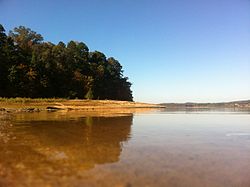Clemson Experimental Forest
| Clemson Experimental Forest | |
|---|---|

A view from Lake Hartwell of the Clemson Experimental Forest
|
|
 Location of Clemson, South Carolina |
|
| Coordinates: 34°41′6″N 82°48′53″W / 34.68500°N 82.81472°WCoordinates: 34°41′6″N 82°48′53″W / 34.68500°N 82.81472°W | |
| Country | United States |
| State | South Carolina |
| Counties | Pickens, Anderson |
| Website | [1] |
Clemson Experimental Forest, a 17,500 acre forest surrounding Clemson University, is a natural resource laboratory. It is a product of a land reclamation project funded by Franklin D. Roosevelt Administration's New Deal programs. The forest is habitat for more than 195 species of birds and more than 90 species of trees. The forest is used for research, education, and recreation.
The United States Congress addressed the problem of sub-marginal agricultural lands in the Agricultural Act of 1929. In 1933, with an effort to improve economic conditions, President Franklin D. Roosevelt issued an executive order establishing public funds to be made available to acquire worn-out farmland. In August 1933, Dr. George Aull, a 1918 graduate of Clemson Agricultural College, sent a proposal for Fant’s Grove Community Development Project to Washington. He proposed that the government purchase 8,500 acres. This proposal was turned down. He adjusted his proposal, now named the Clemson College Conservation Project, and resubmitted it. Under the condition that the government would own and manage the land, the proposal was accepted. E.W. Sikes, president of Clemson College at the time, named Aull project manager. Work of the project started in August 1934. Starting off, Aull directed men to clear stands of timber, to build fire lanes, and to clear streambeds. Aull hired two Clemson College engineers to design and build a dam on Six Mile Creek to form Lake Issaquena. He also started them planting seedlings. In particular, the men planted gum, pine, poplar and oak. At the end of his second year as project manager, Aull decided to resign his duties and regain his position as chairman of the Department of Agricultural Economics at Clemson. Between 1942 and 1945, one hundred thirty-five acres of northern forest were leased to the United States Air Corps for bombing practice. In 1946, Clemson’s President R.F. Poole hired Norbert B. Goebel, a graduate in forest management of Duke University, as Forest manager of the project, then known as the Land Use Project. On December 22, 1954, a bill introduced by Senator Charles E. Daniel and Senator Strom Thurmond was passed deeding the 27,469 acres of land of the project to Clemson College for the price one dollar. This bill reserved the United States certain mineral rights and restricted the lands to be forever used for public purposes. In 1977, the Forest was selected by the Institute of Ecology as one of the 67 primary experimental ecological reserves in the nation. Only 17 of the 171 considered ranked higher than Clemson.
...
Wikipedia
